| The Wellcome Diary and Johnson Photographic Year Book |
|
|
|
|
The Johnson Photographic Year Book (the Brown/Red covered example illustrated is for 1962) was primarily a compendium of photographic information with 92 pages of text and tables. It measures some 14cm tall x 9cm. At the back are two rotary exposure calculators, one for negative materials and one for reversal. These Year Books had covers in various colours depending upon their year e.g. in 1953, 1958, 1963 & 1965 it was blue. In 1957 & 1961 it was Green, in 1959 it was dark red, while in 1960 it was Grey. At that time it was priced at 6/6d (32.5p). |
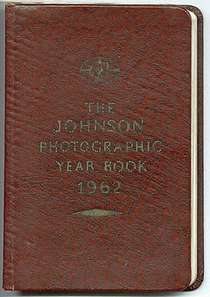 |
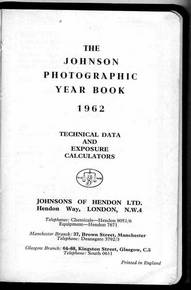 |
| In 1964 The Johnson Photographic Year Book was red, and still priced at 6/6d. In 1969 it was Green again. |
A separate diary and exposure record was held in place by a loop on the inside front cover. When it was phased out (believed to be 1971) it was priced 7s.3d (36p). |
|
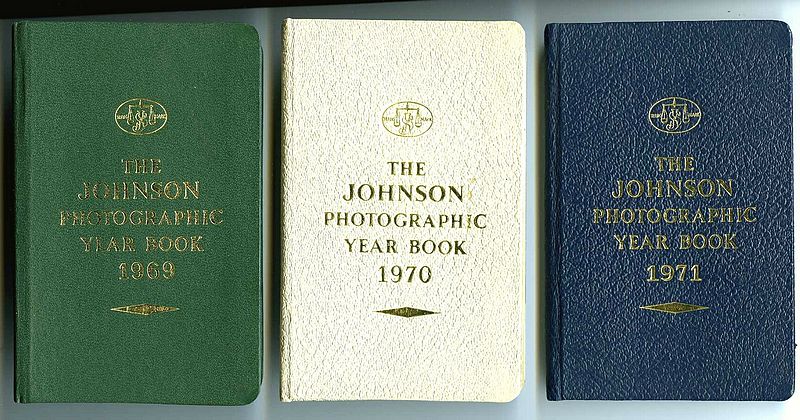 |
Covers of the last three issues of the Johnson Photographic Year Book, each with its insert of the separate Diary & Exposure Record. My thanks to John Tranter for finding my site and getting these three items to me. To see a pdf file of some of the content pages of the 1969 Year Book, click here (courtesy of Richard W Holzman). |
|
|
Burroughs Wellcome & Co.
'Tabloid' Metol-Quinol Developer, "an ideal all-round developer
for plates, films, bromide or gaslight papers and lantern slides.
Recommended also for stand, tank or machine development." TIME AND TANK DEVELOPMENT FACTORIAL DEVELOPMENT Directions: Normal Developer for Negatives and Bromide Papers:
Dissolve one 'Tabloid' Metol-Quinol in each two ounces of water
and add one 'Tabloid' Metol-Quinol Accelerator. Below are shown three examples of different packaging of the Metol-Quinol (M&Q) Developer. |
||
 |
.jpg) |
|
.jpg) .jpg) .jpg) |
|
|
|
Burroughs Wellcome & Co. 'Tabloid' Fine-Grain Developer. The box pack measures 6cm wide by 7.5cm high by 4cm depth. It holds two bottles, one with a metal screw cap (identified as 'A') the other with a cork (identified as 'B'). Both hold 15 tablets. Directions - Drop the products whole into the stated amount of water. Then IMMEDIATELY powder them by pressure with a glass or ebonite rod and stir until dissolved. The products must not be left whole in the water but must be powdered at once. Normal Developer - For dish development or small tanks. One tablet 'A' plus one of 'B' into 2 fluid ounces of water. Time and Tank Development. To make an Ultra-Fine Grain
Developer - dissolve
the tablets in 2 ounces of warm water and then add an equal
volume of 20% sulphite solution, made by dissolving 2 ounces
of anhydrous sodium sulphite in 7 ounces of hot water and
, when cool, making up to 10 ounces. Factorial Development To download a (1947 ?) PDF file of the instructions for Wellcome's 'Tabloid' Fine-Grain Developer, click here. |
||
.jpg) |
.jpg) |
|
|
Burroughs Wellcome & Co. Pyro-Soda Developer (Ilford Formula). The Directions state: Pyro-Soda was Ilford developer ID-1 |
||
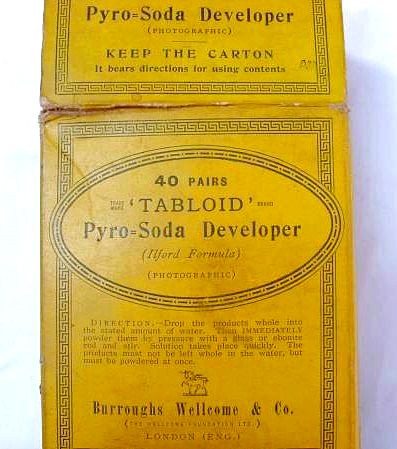 |
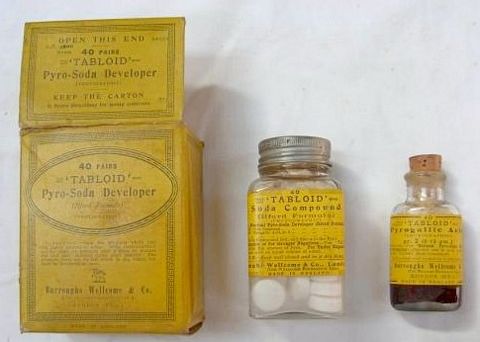 |
|
| Burroughs Wellcome & Co. 'Tabloid' Amidol Developer (pictures courtesy of Diona de Graaf) | ||
.jpg) .jpg) |
Amidol is 2:4 Diaminophenol Hydrochloride (Ref: The Johnson Photocopoeia). On the front of the the Amidol Developer box, the Directions are the standard ones which appear on most of the packages i.e. "Drop the products (two per pack; see left) whole into the stated amount of water. Then IMMEDIATELY powder them by pressure with a glass or ebonite rod and stir. Solution takes place quickly. The products must not be left whole in the water, but must be powdered at once". Specific to the Amidol Developer, Instructions state "For Negatives, Bromide or Gaslight Papers and Lantern Slides. In each ounce of water, first dissolve one 'Tabloid' Amidol Accelerator, and then add one 'Tabloid' Amidol. For soft grey tones on bromide papers, dilute with an equal volume of water. If a restrainer be required, 'Tabloid' Sodium Citrate gr.1, is the most suitable". Normal time for development at 60°F; 4 minutes. The time varies considerably with different plates and films and at different temperatures (see Time and Temperature Tables in 'Directions' circular, enclosed - missing from this pack). Factorial Development. Multiply the time which elapses between
application of developer and first visible sign of an image by
one of the factors below. .jpg) |
|
|
During the 1940s, Wellcome seem to have temporarily stagnated and in 1949, possibly in search of new focus, Borroughs Wellcome & Co (The Wellcome Foundation Ltd) arranged that Johnsons of Hendon Ltd become sole distributors of their novel 'Tabloid' brand photographic products. It was emphasised that Manufacture would still be carried out by Burroughs Wellcome & Co; only the packaging and marketing would be carried out at Hendon. In the early 1950s, Johnsons were selling 'Tabloid' M.Q, Fine-Grain, 'Rytol' and Amidol developers alongside their own brands. By the early 1960s, Johnsons only listed 'Tabloid' Fine-Grain and even this had disappeared from their chemicals price list by 1965. |
||
|
|
Burroughs Wellcome & Co Tabloid M-Q Developer in 1953, when it was being packaged and distributed by Johnsons of Hendon Ltd. Click here
for a (1953 ?) PDF download of the leaflet that accompanied this
M-Q developer pack and which contains instructions for the Tabloid
developers: |
|
|
Wellcome's
Photographic Diary (RH) From the start of the 20th century, Burroughs Wellcome & Co sold a booklet (at times, in two forms - see the following), which comprised useful photographic information, exposure guidance, a diary and a place to record exposures. The British Library holds a copy dated 1900. In 1900 it was named Wellcome's Photographic Diary and Exposure Record, 1900. From 1901 to 1910 it was entitled
Wellcome's Photographic Exposure Record and Diary. |
||
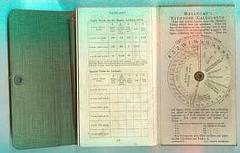 Wellcome's Photographic Exposure Record and Diary, 1907, (back pages) |
The 1903 edition introduced the familar 'wrap-around' cover and rotary calculator. The earlier form of a conventional booklet, as used with the 1900 to 1902 editions, was still available, price 1/- (5p) but also a 3-fold wrap-around design of cover (see left, alongside) was intoduced, initially as "leather bound and with superior binding", priced at 2/- (10p). This 'superior' red leather covered version is thought to not have sold well and was subsequently abandoned in favour of lower cost cloth covers, retailing for 1/- even in the 3-fold wrap-around design. Both 1903 versions had the new rotary calculator ("for which no reasonable person would demur from paying the price of the whole book") which enabled Wellcome to simplify their tabulated exposure data. By 1904 a southern hemisphere version, in a blue cloth wrap-around cover design, was available. For examples of the blue version, see below. A red covered US Edition was announced in 1907 with a "red cloth cover". For examples of the red covered version, see below. A 1907 copy was sold on UK e-bay, November 2004, for £11.05p, with the vendor saying "measuring 14x9 cms when closed and containing a diary, pencil, a pouch for storing exposure papers and a Wellcome's exposure calculator. Full of lots of useful photographic information and adverts, for the world-wide photographer. In excellent order, but has been used with some notes made etc." Another UK 1907 version "unused in good clean condition with original pencil and exposure calculator" was sold in November 2005 for £20. |
|
| Wellcome's Photographic Exposure Record and Diary, USA edition | ||
 Wellcome's Photographic Exposure Record and Diary, 1907, red covered US edition (RH) |
Richard W Holzman in the USA has a 1907 edition but his has red covers. He also has 1912 and 1939 editions with red covers. Richard's 1907 edition came with a Sales Sheet (see right) within the 'pocket' of the diary which states that the 'Wellcome' diary was made in 3 editions; (i) 'US edition', |
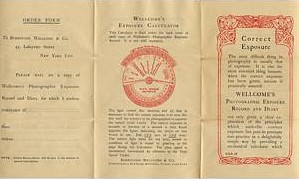 Click here or the Sales Sheet image to enlarge |
| Since all of Richard's Wellcome diaries purchased in America have red covers, it seems that the 'US edition' of the Wellcome Diary mentioned on the above Sales Sheet, was red covered, while the Northern Hemisphere (UK) editions were green covered. Barry Levinson has let me know that he has 1915 red covered version of the Wellcome Photographic Exposure Record & Diary which he believes also came from the USA. On page 3 of Barry's edition is a blue & green toned (Rytol Tabloid universal developer) photograph of a Blue Hyacinth. Its a brilliant photo ! | ||
| Wellcome Photographic Exposure Record and Diary (1911-22); Wellcome Photographic Exposure Calculator, Handbook and Diary (1922-41) | ||
| In 1911 until
1921, the diary changed its name to the Wellcome Photographic
Exposure Record and Diary i.e Wellcome's became Wellcome.
The diary was then only available in its 3-fold form. Then, from 1922 to 1941 it was named the Wellcome Photographic Exposure Calculator, Handbook and Diary. |
||
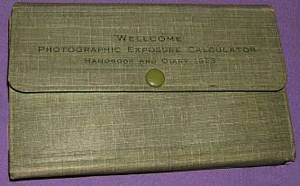 1923 Wellcome Photographic Exposure Calculator, Handbook and Diary. |
In 1924, Burroughs Wellcome & Co. became The Wellcome Foundation Ltd.
In 1937 the diary cost 1/6d (7.5p) and I believe
it was that price from at least the mid-1920s. Information from the current owner (Brian Wilkinson) is that Mr Cullingford died in the 1990s. Entries in his diary relate to trips around Kent and East Sussex using a Super Ikonta. He later bought an Agfa Karat to 'move into colour ' in 1939. |
|
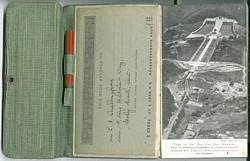 Wellcome Photographic Exposure Calculator Handbook & Diary, 1937, front pages |
||
|
The Royal Photographic
Society's Diary for 1925 This Diary is now ready and copies can be obtained from the Secretary, price 2/- each (post free). In addition to the usual Diary contents, it contains a fund of information of practical value and interest. The articles "Successful Photography" and "Photography with a Purpose" are especially intended for the guidance of the beginner and contain many valuable suggestions. The Diary also contain an exposure meter, and a useful feature is the provision of a number of pages at the end for recording exposure, ruled spaces being provided for the following data :- Date, plate, light, stop, exposure, subject and number of negative". The Preface ends "The Council desire to express their indebtedness to Mr. A. C. Banfield, F.R.P.S., and to Mr. Olaf Bloch, F.I.C, F.R.P.S.. for their invaluable assistance in contributing articles and to Messrs. Ilford, Limited, for the permission to use the Ilford Exposure Meter (from which it has been adapted) as the basis of the Diary Meter. The RPS diary can be viewed by downloading the pdf here, courtesy of Richard W Holzman. As far as is known, no other RPS diaries were published. |
||
| Wellcome
Photographic Diary, Southern Hemisphere Below are shown a 1937 Southern Hemisphere and Tropics edition, this time coloured light blue. So it seemes it was Green for the UK, Red for the USA and Blue for the Southern Hemisphere. |
||
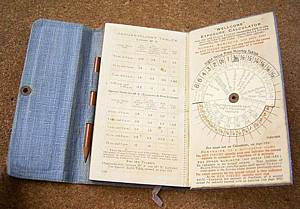 |
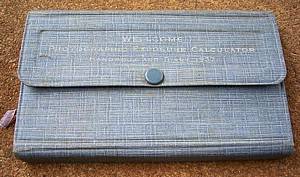 |
These pictures taken from the Australian ebay site show a 1937 edition of the Wellcome Photographic Exposure Calculator Handbook and Diary. They show that the Southern Hemisphere and Tropics edition had a pale blue cover (RH). For more close up scans of a 1941 Australia & Tropics edition, courtesy of Richard Holzman, click here. |
| Wellcome
Photographic Exposure Guide; War Emergency Edition (1943) Pictures below and right, courtesy of Richard W Holzman |
||
|
'Wellcome' suspended publication of The 'Wellcome' Photographic Exposure Calculator, Handbook & Diary. They instead published this 20 page Emergency Edition. 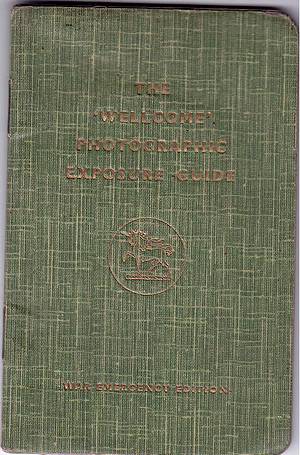 "Wartime conditions have made it impossible for us to issue the familiar 'Wellcome' Photographic Diary and Exposure Calculator. To meet the urgent requests of many photographers both professional and amateur who are "carrying on" as best they may, we have therefore produced this Guide to Exposure. It is hoped that this may serve in some measure to compensate for the absence of new editions of the 'Wellcome' Photographic Exposure Calculator, Handbook and Diary until the end of the war." |
 1943 Emergency Edition - Front Pages |
|
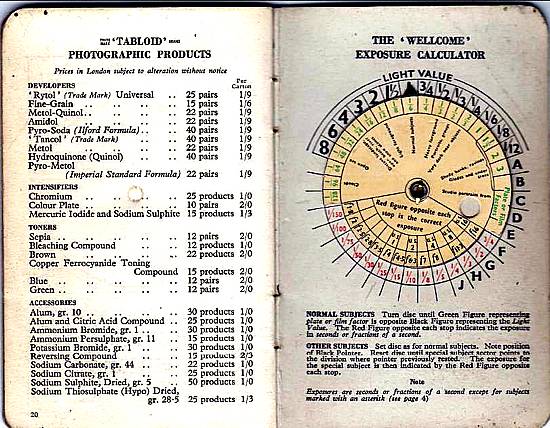 1943 Emergency Edition - Back Pages |
||
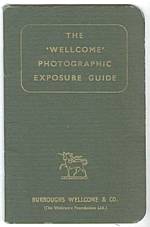 |
1946... "....yet another Emergency Edition of the 'Wellcome' Photographic Exposure Guide has been found neceesary". The 1946 Emergency Edition of the 'Wellcome' Photographic Exposure Guide (shown left) was complete with Exposure Calculator and instructions, including an illustrated guide to the calculator's subject descriptions. There is also a table of speed classifications for all negative materials available at the date. The 1946 edition is little
changed over that of 1943, with differences only in the available
films and some sections of the text. |
|
| 'Wellcome'
Photographic Year Book 1947 & 'Tabloid' Exposure Guide By 1947 the full 100 page diary was again on sale, but now in a more orthodox book form and entitled 'Wellcome' Photographic Year Book 1947. It was joined by smaller volume called The 'Tabloid' Photographic Exposure Guide. See pictures of the diary and the 'Tabloid' below. In the Foreword to the 'Tabloid' it was explained: Burroughs Wellcome & Co. publications are designed to assist the photographer achieve the best results possible with his equipment, whether it be the complex outfit of the advanced worker, or the more simple apparatus of the beginner. In view of the importance of the choice and arrangement of the subject, this publication concentrates attention upon the technical and pictorial aspects of exposure in the camera, making the volume complementary to the larger and more comprehensive 'Wellcome' Photographic Year Book. The sections are necessarily brief. Those dealing with the choice and arrangement of the subject serve to suggest lines of thought and effort rather than an attempt to define hard and fast rules, whilst those dealing with the technical aspects of exposure, although complete in themselves, are dealt with in greater detail in the larger volume. As the guide is intended to be of use to the reader when preparing to make an exposure, attention has been given to the arrangement of the necessary information for easy reference. |
||
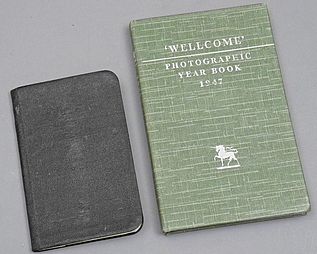 and the Photographic Year Book 1947 (right). (courtesy of Richard W Holzman. A 1948 'Tabloid' was published but no others. The Johnson Photocopœia, published in 1951 (see below). |
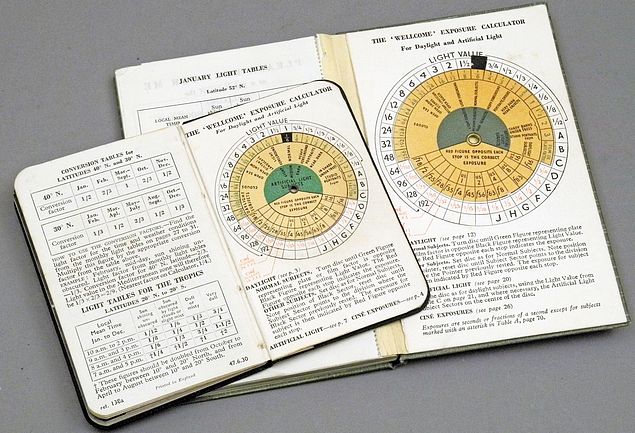 |
|
| In 1949 Johnsons were given publication & selling rights for the 'Wellcome' Photographic Year Book. For the detailed announcement, as appeared in the BJPA of 1949, click here (RH) | ||
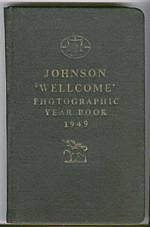 |
The 1947 and 1949 copies (at least) had two rotary calculators at the rear, one being the usual 'Wellcome' Exposure Calculator for Daylight and Artificial Light, the other being a 'Wellcome' Depth of Field Calculator. In 1949 the title became the Johnson 'Wellcome' Photographic Year Book. For two or three years it bore both the Johnsons 'Scales' trade mark as well as the Wellcome 'Unicorn', as the version shown to the left. It contained 100 pages of useful information, a diary for the year, space for recording exposures and a 'speedy and accurate exposure calculator'. It cost 5/- (25p). Around 1950 the Tabloid range included 'Rytol', Fine Grain, M-Q and Amidol developers, plus Chromium Intensifier, Ammonium Persulphate Reducer, Potassium Bromide, Potassium Ferricyanide and Wetting Agent. |
|
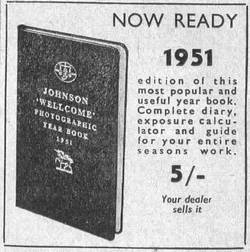 |
The Johnson Photographic
Year Book, 1951 Its possible two versions of the diary were published in 1951, one bearing the 'Wellcome' name and one (a later edition?) without. To the left is an Amateur Photographer advert from the 31st Jan 1951 issue, but in a Johnsons advert in the 1952 BJPAlmanac the same 1951 diary is shown without naming 'Wellcome'. Meanwhile, an entry in 'Photography' magazine for December 1951 provides the information that 1952 "is the first year that the name Wellcome has not been included in the title." Hence, although there is some doubt about 1951, from 1952 it is known for certain the title was The Johnson Photographic Year Book. From 1953 Johnsons made the diary and exposure record pages a soft covered insert to the main hard-back covered Year Book of photographic information. This soft covered insert was held within the hard covers by means of a cardboard 'strap' on the inside of the Year Book's hard backed front cover. (RH) reports that The Johnson Photographic Year Book for 1953 (with a single exposure calculator) has an entry in the preface stating that this separable format was to reduce Purchase Tax. However, it is believed that the two 'halves' were never actually sold separate from each other. The 2-part arrangement seems to have persisted throughout the publication life of the Year Book. 1971 is believed to have been the last year of publication of the Johnson Photographic Year Book. It is mentioned in the news section "What's New" in Amateur Photographer magazine for 25th November 1970. "A very useful present for a beginner; the cost is 7s.3d" (36p). "...a removeable diary with about 30 pages for exposure records and a semi-permanent booklet containing over 90 pages of useful photo data". |
|
| To see a pdf file of some of the content pages of The Johnson Photographic Year Book, 1969 and its Diary and Exposures Record insert, click here (courtesy of Richard W Holzman). | ||
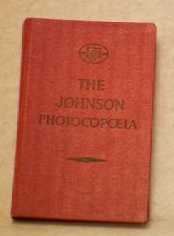 |
The Johnson Photocopœia "Tastefully bound in red leather cloth with gold-blocked lettering." Johnsons seem to have phased out the 'Wellcome' Tabloid products by 1965, possibly seeing their own 'Pactum' range (small, individual packs of powder chemicals) as filling the same market niche. |
|
|
Sir Henry Wellcome died at the age of 82 on July 25th 1936. |
||
|
|
|
|
|
|
||
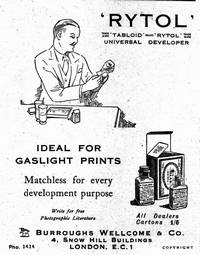
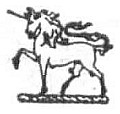
.jpg)
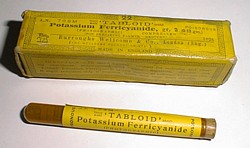
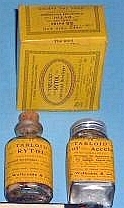
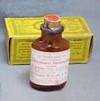 'Tabloid' Chromium Intensifier.
'Tabloid' Chromium Intensifier.
 Starting
in the 1950s, the fortunes of 'The Wellcome Foundation' were
transformed with the introduction of a number of important pharmaceutical
products which did much to improve the quality of life by preventing
or treating some of the world's most unpleasant diseases. Glaxo
Wellcome was formed in 1995 and at the end of the 20th Century
was the largest pharmaceutical company in the world.
Starting
in the 1950s, the fortunes of 'The Wellcome Foundation' were
transformed with the introduction of a number of important pharmaceutical
products which did much to improve the quality of life by preventing
or treating some of the world's most unpleasant diseases. Glaxo
Wellcome was formed in 1995 and at the end of the 20th Century
was the largest pharmaceutical company in the world.